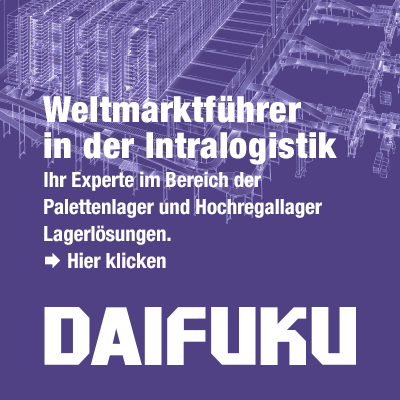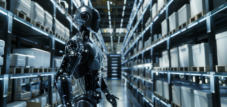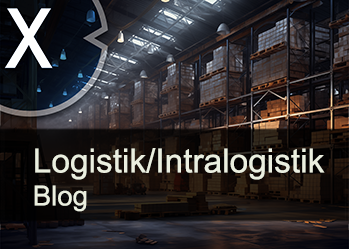Reaching new heights in warehouse logistics instead of expanding expensively: The simple physics that pushes mobile warehouse robots to their limits
Xpert pre-release
Language selection 📢
Published on: November 3, 2025 / Updated on: November 3, 2025 – Author: Konrad Wolfenstein

Reaching new heights in warehouse logistics instead of expanding expensively: The simple physics that pushes mobile warehouse robots to their limits – Image: Xpert.Digital
The hype surrounding mobile robots: Most warehouse planners overlook this crucial detail.
Robot versus crane: The surprising winner in the battle for the future of the warehouse
In a logistics world dominated by the hype surrounding swarms of autonomous mobile robots (AMRs), the verdict on traditional technologies seems to have already been passed. But while flexible robots navigate the aisles, a proven solution is experiencing a quiet yet powerful renaissance: the automated small parts warehouse (AS/RS), also known as the mini load warehouse. The reason for this is not nostalgia, but hard-nosed physics and economics. The relentless rise in land prices and increasing cost pressures are forcing companies to reassess an often overlooked dimension: height.
This article highlights why rail-mounted storage and retrieval machines are not a thing of the past, but rather demonstrate superiority in crucial areas that mobile systems cannot match. It's about the unbeatable efficiency of vertical space utilization, which enables a doubling of storage capacity on the same footprint. It's about the inherent physical advantages in storage density and throughput speed, essential for the smooth operation of production and e-commerce centers. And last but not least, it's about the often underestimated energy efficiency and decades of reliability, especially under extreme conditions such as in deep-freeze warehouses. The true future of intralogistics lies not in an either-or decision, but in an intelligent symbiosis where the unwavering strength of fixed automation forms the foundation for the flexible agility of mobile robots.
Why proven storage technology doesn't have to fear the mobile revolution, but rather complements it
In the seemingly unstoppable wave of mobile robotics solutions sweeping through modern warehouses, a fundamental truth is in danger of being forgotten: the physics of space utilization and the economics of energy supply cannot be outsmarted by flexibility alone. Mini Load Automated Storage and Retrieval Systems, those supposedly venerable storage and retrieval machines with their rail-mounted cranes, are not experiencing a nostalgic demise, but rather a remarkable renaissance in an era that seems obsessed with mobile agility. The question is not whether mobile autonomous robots represent the future of intralogistics, but why this supposedly inflexible alternative demonstrates a superiority in certain dimensions that no swarm of autonomous units can achieve.
The economic surveying of vertical space
The fundamental challenge of modern warehousing manifests itself in a simple yet unyielding equation: Land in urban centers and strategically advantageous logistics zones is becoming exponentially more expensive, while the demand for storage capacity is constantly increasing due to the booming e-commerce sector. The global business-to-consumer e-commerce market is heading towards a volume of US$5.5 trillion by 2027, with an annual growth rate of 14.4 percent. This explosive expansion is creating a demand for storage that can no longer be met with traditional two-dimensional space concepts.
Herein lies the first crucial advantage of Mini Load AS/RS systems: their ability to expand vertically. While autonomous case-handling robots typically operate at heights of eight to twelve meters, Mini Load stacker cranes reach working heights of up to twenty meters. This near doubling of vertical reach translates in practical application not only into a linear increase in storage capacity, but also a fundamental transformation of space efficiency. A warehouse that grows vertically rather than horizontally not only avoids the costs of additional land, but also proportionally reduces the expenses for soil sealing, foundations, and building envelopes per stored unit.
Market data impressively underscores this strategic importance. The global market for automated storage and retrieval systems was valued at US$9.08 billion in 2024 and is projected to grow to US$14.95 billion by 2032, representing an average annual growth rate of 6.6 percent. This development parallels the explosive growth of mobile robotics solutions: The market for autonomous mobile robots is expanding from US$2.8–4.32 billion in 2024 to a projected US$8.7–14 billion by 2032, with annual growth rates between 16.4 and 23.7 percent. The fact that both technologies are experiencing robust growth simultaneously signals not displacement, but rather differentiation based on specific use cases.
Density as a strategic competitive advantage
Double-deep storage, a concept developed to technical maturity in mini-load systems, exemplifies the principle of storage density. In this configuration, two load units are positioned one behind the other in the same shelf compartment, halving the number of aisles required and increasing storage capacity by thirty to forty percent while maintaining the same footprint. While autonomous mobile robots can theoretically also handle double-deep configurations, they encounter physical limitations: access to the rear position slows down considerably because the front container must first be moved. Mini-load storage and retrieval machines, on the other hand, have telescopic load handling devices that can reach both positions at comparable speeds.
This speed of access becomes the second crucial differentiating factor. A storage and retrieval machine operates on a fixed rail within a controlled aisle, achieving cycle times that remain unattainable for mobile systems. While a single autonomous robot can take several minutes for a typical storage or retrieval operation, depending on the distance and traffic situation within the warehouse, a mini load crane completes combined double cycles in seconds. In a combined cycle, the storage and retrieval machine picks up a load unit from the entrance, travels to the storage position, places the unit down, picks up another unit in the same movement, and transports it to the exit. This efficiency of movement drastically reduces empty runs and maximizes throughput per unit of time.
For high-throughput applications, such as supplying production lines, consolidating finished goods, or delivering to picking zones, this speed advantage translates into a systemic performance advantage. To keep pace with a single mini-load storage and retrieval machine, a fleet of autonomous robots would be required, which leads to a paradox: a warehouse full of mobile robots is no longer open and flexible, but rather cramped and congested. The complexity of fleet management increases exponentially with the number of units, while traffic jams, collision avoidance, and load coordination become operational bottlenecks.
The energy superiority of direct power supply
The question of energy supply reveals an often overlooked but fundamental weakness of mobile robot systems. Autonomous mobile robots and autonomous case-handling robots rely on lithium-ion batteries, which necessitates a complex infrastructure for charging, battery swapping, and maintenance. These battery systems are subject to cyclical degradation effects that reduce their capacity over their lifespan. After just a few years of intensive use, batteries must be replaced, incurring significant costs. Furthermore, the robots require charging times, which can lead to bottlenecks during peak load periods. Battery management systems must be continuously monitored to prevent conditions such as overcharging, overheating, or deep discharge.
In cold storage and deep-freeze environments, this problem is dramatically exacerbated. Lithium-ion batteries lose significant performance at low temperatures and require integrated heating systems to remain operational. These heaters consume additional energy, increasing operating costs and reducing the operating time per charge cycle. Mini Load AS/RS systems, on the other hand, draw their energy continuously via busbar systems, power-carrying rails that ensure an uninterrupted power supply. There are no charge cycles, no battery swaps, no energy storage degradation, and no performance-reducing temperature effects.
This energy superiority is not just a matter of operating costs, but also of system reliability. A warehouse that relies on battery-powered robots must incorporate redundancies to compensate for outages caused by discharged or defective batteries. The sizing of the charging infrastructure, the availability of spare batteries, and the logistics of battery replacement become critical factors that significantly impact the overall investment. Mini Load systems completely eliminate this level of complexity. Once the system is powered up, it is continuously available. This simplicity of power supply translates into reduced maintenance requirements and higher availability rates.
The test of resilience in extreme environments
Deep-freeze warehouses present a unique challenge for any form of automation. Temperatures of minus thirty degrees Celsius and below lead to thermal contraction of materials, increased wear on mechanical components, and, as mentioned, drastically reduced battery performance. Mini Load AS/RS systems were specifically designed for such extreme conditions. Daifuku, a global market leader with a revenue of 737.32 billion yen in 2024 and over 34,000 AS/RS cranes installed worldwide since 1966, installed its first deep-freeze capable system for temperatures down to minus forty degrees Celsius as early as 1973. Some of these systems are still in operation today, demonstrating not only the robustness of the technology but also its long-term economic viability.
In cold storage facilities, automated systems offer the additional advantage that human workers do not have to be constantly exposed to extreme temperatures. Order picking can take place at ergonomic transfer points outside the cold zone, while the automated storage and retrieval system (AS/RS) handles storage and retrieval inside. While mobile robots can theoretically perform this task as well, they must constantly move between warm loading zones and cold working areas, causing temperature fluctuations and condensation effects that can lead to corrosion and electronic failures.
The pharmaceutical, food logistics, and electronics industries rely on mini load systems not only for their temperature resistance but also for their precision and reliability. In manufacturing environments where production lines require a continuous supply of small parts, components, and tools, a system failure can lead to costly production downtime. The average lifespan of a mini load system is fifteen to twenty years, with maintenance costs of only one to three percent of the investment per year. Some systems have been operating reliably for over fifty years, enabling amortization over decades.
Xpert partner in warehouse planning and construction
Hybrid strategy for warehouses: Mini-Load meets mobile robots
The strategic repositioning in the hybrid automation concept
The debate about mini-load AS/RS versus autonomous mobile robots is based on a false dichotomy. The most intelligent strategy lies not in choosing one technology over the other, but in the hybrid integration of both approaches. Fixed automation, which includes mini-load systems, is characterized by density, throughput, and reliability. Flexible automation, represented by mobile robots, scores points with adaptability, modular scalability, and low initial investment.
A hybrid warehouse concept utilizes mini-load systems for high-frequency, predictable goods flows, such as best-selling items with constant turnover. The vertical capacity and high throughput of these systems maximize efficiency in these zones. Autonomous mobile robots, on the other hand, handle dynamic transport tasks, such as horizontal transfer between different warehouse areas, supplying picking stations, or managing seasonal and variable product ranges. This division of labor combines the strengths of both technologies and minimizes their respective weaknesses.
Implementation speed plays a strategic role. While autonomous mobile robots are ready for deployment within six to eight months, mini-load installations require fourteen months or more. Companies can therefore start with mobile systems to quickly realize initial automation gains and simultaneously plan long-term mini-load projects that will raise capacity and efficiency to a new level in the long run. In this scenario, mobile robots act as a bridging technology and a complementary layer of flexibility, not as a replacement.
The warehouse automation market as a whole underscores this coexistence. With projected growth from $26.5 billion in 2024 to $115.8 billion by 2034, representing an annual growth rate of 19.9 percent, the sector is absorbing both technological directions. North America holds a market share of over 35 percent, Europe approximately 22 percent, while the Asia-Pacific region boasts the highest growth rates. This geographic diversification reflects differing starting points: While established markets are driving hybrid modernizations, growth markets are focusing on new installations with high automation density.
The economic rationality of longevity
An often underestimated factor in total cost analysis is the lifespan of the systems. While autonomous mobile robots are subject to rapid technological obsolescence and must be replaced by newer models after five to seven years, mini load systems operate for decades. This longevity results from their mechanical robustness and lower reliance on rapidly obsolete electronics. The control software can be modernized without replacing the mechanical infrastructure, enabling upgrades that further extend the lifespan.
The total cost of ownership, which includes not only the initial purchase price but also operation, maintenance, energy, and replacement investments, shifts significantly in favor of AS/RS systems in the long term. While the initial investment for a mini-load system is higher than for a mobile robot fleet, it pays for itself over the decades through lower operating costs, higher availability, and the absence of technology cycles. Companies with a long-term strategic focus and stable product portfolios benefit massively from this investment stability.
The investment decision is also influenced by regulatory and sustainability considerations. Energy consumption per moving charging unit is lower for mini load systems than for battery-powered mobile units, especially when regenerative braking systems are used to recover braking energy. These systems convert kinetic energy during braking into electrical energy, which is fed back into the grid, significantly reducing net energy consumption. In an era of rising energy costs and stricter sustainability requirements, this efficiency is becoming a competitive advantage.
The renaissance of proven technology in the digital age
Digital transformation and Industry 4.0 have fundamentally changed expectations for intralogistics systems. Real-time data, predictive maintenance, complete transparency, and integration with higher-level warehouse management systems are no longer optional, but essential. Modern-generation Mini Load AS/RS systems fully meet these requirements. Sensors continuously monitor operating parameters, algorithms optimize movement sequences in real time, and machine learning models predict maintenance needs before failures occur.
Integration into digital ecosystems is no more complex than with mobile robots. Modern AS/RS systems communicate with ERP systems, WMS platforms, and MES solutions via standardized interfaces. They deliver granular data on every single warehouse access, every movement, and every system status. These data streams enable not only precise inventory management but also comprehensive analyses for process optimization. The claim that fixed systems are less intelligent or less networked than mobile ones does not stand up to technical scrutiny.
The crucial difference lies not in digital capability, but in physical architecture. A mini load system is a long-term investment in a specific spatial solution, while mobile robots represent a flexible but less dense and lower-throughput alternative. Digitization does not eliminate the need to address these fundamental physical questions. It merely makes both approaches smarter, more interconnected, and more efficient in their respective domains.
The cultural dimension of technology choice
A subtle yet relevant aspect of technology decisions lies in a company's organizational culture and risk tolerance. Mobile robotics promises rapid success, low barriers to entry, and maximum flexibility. These attributes appeal to startups, rapidly growing e-commerce companies, and organizations with a highly fluctuating product mix. The ability to scale or reconfigure the system within a few months aligns with the agile business philosophy of modern digital companies.
Mini Load AS/RS systems, on the other hand, require long-term planning, precise demand analyses, and a certain degree of stability in the product portfolio. These requirements are well-suited to established industrial companies, logistics service providers with long-term contracts, and industries with high process stability. The Japanese manufacturing philosophy that shapes companies like Daifuku is based on continuous improvement, meticulous attention to detail, and a zero-defect mentality. These values are manifested in systems that operate reliably for generations.
The geographical distribution of market shares reflects these cultural differences. Europe, with its strong tradition in mechanical engineering and automation, shows a high level of acceptance for both technologies. North America, dominated by giants like Amazon, which are investing heavily in mobile robotics, is driving the growth of autonomous systems. The Asia-Pacific region, led by China and Japan, combines aggressive automation with a focus on efficiency and density, which benefits mini-load systems.
The answer to the opening question
Why does the Mini Load AS/RS perform exceptionally well in a mobile-first world? The answer lies not in its contradiction to the mobile revolution, but in its complementarity. The areas where mobile robots fall short are precisely those where Mini Load systems excel: vertical reach, storage density, throughput speed, and energy efficiency. These parameters cannot be compensated for by software updates or swarm intelligence; they are fundamentally physical and energetic in nature.
A warehouse relying solely on mobile robots forgoes the opportunity to efficiently utilize vertical space, sacrifices throughput potential, and accepts higher energy costs. A warehouse relying solely on mini-load systems loses flexibility, cannot expand modularly, and is slow to adapt to new requirements. The intelligent solution lies in hybrid integration: mini-load systems for core processes with high turnover and stable product ranges, and mobile robots for dynamic peripheral areas and variable tasks.
The data shows that both markets are growing robustly, suggesting not cutthroat competition but rather specialization. The global market for AS/RS is growing at a moderate but stable 6.6 percent annually, while autonomous mobile robots are expanding at an explosive rate of 16 to 23 percent. This divergence signals that mobile robotics is unlocking new use cases that were previously not automated, while AS/RS systems are defending and moderately expanding their established domains.
The true superiority of the Mini Load AS/RS lies in its proven, reliable, and physically superior solution for specific requirements. In a world obsessed with disruption and constant change, something that has worked for decades and will continue to work exerts an underestimated appeal. The renaissance of the vertical dimension is not nostalgic, but rational. It is based on the understanding that not every innovation renders the existing obsolete, but rather that the intelligent combination of the tried and tested and the new shapes the future.
The intralogistics of the coming decades will not be either mobile or fixed, but both, orchestrated by intelligent software, optimized for specific requirements, and aligned with the physical and economic realities of space, energy, and throughput. In this context, the Mini Load AS/RS doesn't play second fiddle, but rather forms the foundation upon which the flexibility of mobile systems is built.

Xpert.Plus warehouse optimization - high-bay warehouses such as pallet warehouses consulting and planning
We are there for you - advice - planning - implementation - project management
☑️ SME support in strategy, consulting, planning and implementation
☑️ Creation or realignment of the digital strategy and digitalization
☑️ Expansion and optimization of international sales processes
☑️ Global & Digital B2B trading platforms
☑️ Pioneer Business Development
I would be happy to serve as your personal advisor.
You can contact me by filling out the contact form below or simply call me on +49 89 89 674 804 (Munich) .
I'm looking forward to our joint project.
Xpert.Digital - Konrad Wolfenstein
Xpert.Digital is a hub for industry with a focus on digitalization, mechanical engineering, logistics/intralogistics and photovoltaics.
With our 360° business development solution, we support well-known companies from new business to after sales.
Market intelligence, smarketing, marketing automation, content development, PR, mail campaigns, personalized social media and lead nurturing are part of our digital tools.
You can find out more at: www.xpert.digital - www.xpert.solar - www.xpert.plus

























